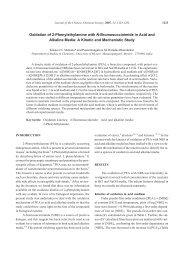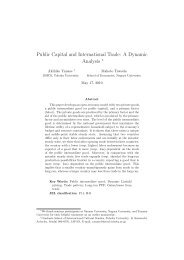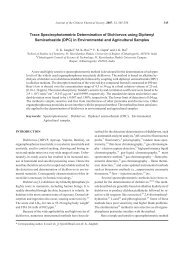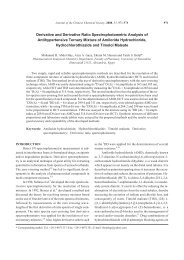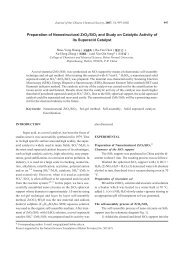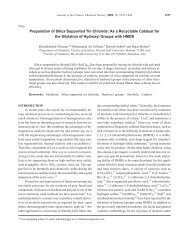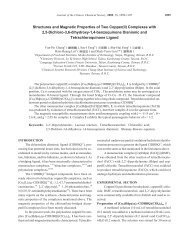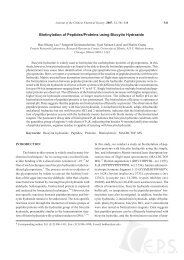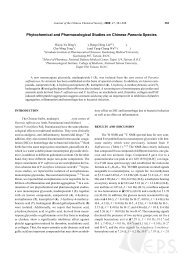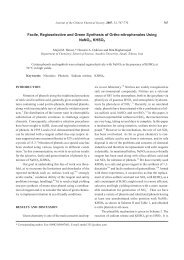Synthesis of Gold Nanosheets through Thermolysis of Mixtures of ...
Synthesis of Gold Nanosheets through Thermolysis of Mixtures of ...
Synthesis of Gold Nanosheets through Thermolysis of Mixtures of ...
Create successful ePaper yourself
Turn your PDF publications into a flip-book with our unique Google optimized e-Paper software.
98 Journal <strong>of</strong> the Chinese Chemical Society, 2009, 56, 98-106<br />
<strong>Synthesis</strong> <strong>of</strong> <strong>Gold</strong> <strong>Nanosheets</strong> <strong>through</strong> <strong>Thermolysis</strong> <strong>of</strong> <strong>Mixtures</strong> <strong>of</strong> Long<br />
Chain 1-Alkylimidazole and Hydrogen Tetrachloroaurate(III)<br />
Shih-Jen Hsu ( ) and Ivan J. B. Lin* ( )<br />
Department <strong>of</strong> Chemistry, National Dong Hwa University, Shoufeng, Hualien 974, Taiwan, R.O.C.<br />
Micron-sized gold nanosheets were produced <strong>through</strong> thermolysis <strong>of</strong> a mixture composed <strong>of</strong> 1-octadecanylimidazole<br />
(C 18 -im) and HAuCl 4 in a molar ratio <strong>of</strong> 4:1 at 200 o C for 1 h. Effects <strong>of</strong> the molar ratio<br />
<strong>of</strong> [C 18 -im]/[HAuCl 4 ], the reaction temperature, and the N-alkylimidazole chain length were studied. Adjusting<br />
the molar ratio <strong>of</strong> [C 18 -im]/[HAuCl 4 ] can tune the morphology and size <strong>of</strong> the nanostructures; the<br />
effect <strong>of</strong> reaction temperature is minimum; while using long chain imidazole tends to favor the formation<br />
<strong>of</strong> nanosheets, using 1-methylimidazole (C 1 -im) produces micron-sized polyhedra. The growth mechanism<br />
<strong>of</strong> these nanostructures was proposed. C 18 -im functions both as a templating and capping agent and<br />
favors the growth <strong>of</strong> nanosheets. On the other hand, C 1 -im functions only as a capping agent and thus favors<br />
the formation <strong>of</strong> polyhedra, especially octahedra.<br />
Keywords: <strong>Gold</strong> nanosheets; <strong>Thermolysis</strong>; N-Alkylimidazole stabilizer.<br />
INTRODUCTION<br />
<strong>Gold</strong> nanostructures have been widely studied because<br />
<strong>of</strong> their unique size and shape dependent properties,<br />
which are potentially useful in electronics, catalysis and<br />
especially optics. 1 For example, while a single surface<br />
plasmon resonance (SPR) absorption band is usually observed<br />
for spherical nanoparticles (NPs), more than one<br />
band can be observed for non-spherical AuNPs. Various<br />
chemical and physical methods have been used to synthesize<br />
gold-nanostructured prisms, 2 rods, 1a,3 wires, 4 disks, 5<br />
cubes, 2a,6,7 boxes, 7 rings, 8 sheets 9 and even branched multipods.<br />
1c,10 2D Au nanosheets, in particular, have been attracting<br />
special attention, because they may <strong>of</strong>fer new possibilities<br />
both for research and technological applications 11-15<br />
in surface-enhanced Raman scattering, gas sensing, infrared-absorbent<br />
optical coatings, and inducing hyperthermia<br />
in tumors.<br />
A polyol process, in which a diol or polyol functions<br />
as a solvent and reducing agent, has previously been used<br />
to produce Au nanosheets in high yield. 4,5f,16 Studies have<br />
also been conducted on the reduction <strong>of</strong> aqueous HAuCl 4<br />
by reducing agents, such as amines, 17 oxalic acid, 18 and citrate,<br />
19 to produce Au nanosheets. Separate studies on the<br />
biological synthesis <strong>of</strong> Au nanosheets with seaweed and<br />
lemongrass as reductants have also been conducted. 13<br />
Structured ionic liquids and self-assembled lyotropic liquid<br />
crystals, presumably serving as templates, have recently<br />
provided a further alternative approach to the synthesis <strong>of</strong><br />
Au nanosheets. 20<br />
In this paper, we report a new finding, in which a simple<br />
mixture <strong>of</strong> 1-alkylimidazole and HAuCl 4 produces different<br />
nano- to micrometer-sized Au crystals under thermal<br />
treatment. In brief, heating a mixture <strong>of</strong> N-long chain imidazole<br />
(C n -im, C n =C n H 2n+1 , n = 16, 18) and HAuCl 4 at 200<br />
o C produced hexagonal, triangular and truncated triangular<br />
Au nanosheets with sizes <strong>of</strong> several to tens <strong>of</strong> micrometers,<br />
and with yields <strong>of</strong> greater than 85%. When 1-methylimidazole<br />
was used, polyhedra, particularly octahedra (around<br />
30%), were obtained. To our knowledge, the use <strong>of</strong> this<br />
simple technique to control and synthesize gold nanostructures<br />
in gram quantity has not yet been reported.<br />
EXPERIMENTAL SECTION<br />
Reagents and Materials<br />
Compounds 1-methylimidazole (C 1 -im) and HAuCl 4<br />
were purchased from Aldrich. Compounds 1-octadecanylimidazole<br />
(C 18 -im), 1-hexadecanylimidazole (C 16 -im) and<br />
1,3-octadecanylimidazolium chloride [(C 16 H 33 ) 2 -im][Cl]<br />
were prepared by the known method. 21<br />
<strong>Synthesis</strong> <strong>of</strong> Au(III) Complexes<br />
Preparation <strong>of</strong> [C 18 -imH][AuCl 4 ].[C 18 -imH]Cl (200<br />
mg, 0.56 mmol) and [HAuCl 4 ] (190 mg, 0.56 mmol) in eth-<br />
* Corresponding author. Tel: +886-3-863-3599; Fax: +886-3-863-3570; E-mail: ijblin@mail.ndhu.edu.tw
Fabrication <strong>of</strong> <strong>Gold</strong> <strong>Nanosheets</strong> <strong>through</strong> <strong>Thermolysis</strong> J. Chin. Chem. Soc., Vol. 56, No. 1, 2009 99<br />
anol (50 mL) were stirred for 2 h. The volume <strong>of</strong> the resultant<br />
solution was reduced to 5 mL by rotary evaporator. The<br />
precipitate was filtered and washed two times with ethanol<br />
(5 mL), the solid was collected and dried under vacuum.<br />
The yield was 65%. 1 H NMR (ppm, d 6 -DMSO): 0.83 (t,<br />
3 J = 7 Hz, 3H, CH 3 ), 1.19-1.35 (m, 30H, CH 2 ), 1.77 (m,<br />
2H, CH 2 ), 4.15 (t, 3 J = 7 Hz, 2H, CH 2 ), 7.67 (m, 1H, CH),<br />
7.75 (m, 1H, CH), 9.11 (s, 1H, CH). Anal. Calcd. for<br />
C 21 H 41 N 2 AuCl 4 : C, 38.20; H, 6.26; N, 4.24. Found: C,<br />
38.65; H, 6.44; N, 4.38%.<br />
Preparation <strong>of</strong> (C 18 -im)AuCl 3·C 18 H 37 -im (200 mg,<br />
0.62 mmol) and [HAuCl 4 ] (220 mg, 0.65 mmol) in ethanol<br />
(50 mL) were stirred for 2 h. After which, the solvent was<br />
removed by rotary evaporator. The residue was dissolved<br />
in CH 2 Cl 2 (20 mL), to which silica gel (5 g) was added and<br />
stirred for 30 min. This was then filtered and the filtrate<br />
was collected and dried under vacuum to give the product<br />
with yield <strong>of</strong> 55%. 1 H NMR (ppm, d 6 -DMSO): 0.83 (t,<br />
3 J = 7 Hz, 3H, CH 3 ), 1.19-1.35 (m, 30H, CH 2 ), 1.95 (m,<br />
2H, CH 2 ), 4.15 (t, 3 J = 7 Hz, 2H, CH 2 ), 7.65 (m, 1H, CH),<br />
7.70 (m, 1H, CH), 9.08 (s, 1H, CH). Anal. Calcd. for<br />
C 21 H 40 N 2 AuCl 3 : C, 40.43; H, 6.46; N, 4.49. Found: C,<br />
40.75; H, 6.55; N, 4.35%.<br />
<strong>Synthesis</strong> <strong>of</strong> Au Crystals<br />
To prepare precursor <strong>of</strong> [C 18 -im]/[HAuCl 4 ] (4:1),<br />
C 18 -im (0.38 g, 1.2 10 -3 mmol) and HAuCl 4 (0.10 g, 3.0 <br />
10 -4 mmol) were mixed in ethanol (50 mL) and the mixture<br />
was stirred for 1 h. The solvent was then removed by rotary<br />
evaporator. The residue was collected and dried under vacuum.<br />
To form Au nanostructures, the resultant mixture was<br />
heated at 200 o C for 1 h in a sealed glass tube. These thermal<br />
treated solid products were collected and washed several<br />
times with ethanol. Similar procedures were applicable<br />
for other ratios and imidazoles. Samples with HAuCl 4 up to<br />
1.0 g worked equally well.<br />
Instrumentation<br />
X-ray diffraction analysis <strong>of</strong> the samples was carried<br />
out using an X-ray diffractometer (XRD D8 Advanced,<br />
Bruker and XRD Rigaku D/max-2500, Japan) with Cu K <br />
radiation. The morphology <strong>of</strong> the as-prepared products was<br />
characterized by scanning electron microscopy (SEM,<br />
JMF-6500F. JOEL) and transmission electron microscopy<br />
(TEM, JEOL JEM-3010, operating voltage <strong>of</strong> 300 kV). A<br />
ZEISS Axioplan2 imaging polarizing microscope equipped<br />
with a Mettler FP 82 hot stage and a Mettler FP 90 central<br />
processor was used to examine and follow the growth <strong>of</strong><br />
the nanomaterials. The 1 H NMR spectra were recorded on a<br />
Bruker AC-F300 spectrometer. Infrared (IR) spectra <strong>of</strong> the<br />
samples were measured on a Perkin-Elmer Fourier transform<br />
spectrophotometer (model spectrum one) with a LITA<br />
(lithium tantalite) midinfrared detector.<br />
RESULTS AND DISCUSSION<br />
<strong>Thermolysis</strong> <strong>of</strong> [C 18 -im]/[HAuCl 4 ] = 4:1 at 200 o Cfor<br />
1 h in a sealed glass tube produced mostly shining Au platelets<br />
in >85% yield. To monitor macroscopically the progress<br />
<strong>of</strong> thermolysis, an optical microscope equipped with a<br />
temperature-controlled hot stage was employed. Precursor<br />
<strong>of</strong> [C 18 -im]/[HAuCl 4 ] = 4/1 sandwiched between two slide<br />
glasses showed the melting began at 125 o C; upon continuedheatingto200<br />
o C, small particles are formed at an early<br />
stage; platelets are subsequently formed and grew (Fig. 1).<br />
Since nanoscale particles could not be observed via optical<br />
microscope, the growth <strong>of</strong> nanostructures was followed by<br />
TEM. For a reaction time <strong>of</strong> 1 min, spherical Au NPs in<br />
20-40 nm diameter were observed (Fig. 2a). Increasing the<br />
duration <strong>of</strong> thermolysis to 3 min, worm-like nanostructures<br />
<strong>of</strong> ca. 50~100 nm and nanoplates <strong>of</strong> 60-160 nm lateral<br />
lengths were formed (Fig. 2b1-2). Reaction quenched after<br />
30 min, produced platelets <strong>of</strong> ca. 500 nm lateral lengths<br />
along with small amount <strong>of</strong> irregular faceted particles <strong>of</strong> ca.<br />
100 nm (Fig. 2c). For a reaction duration <strong>of</strong> 60 min, SEM<br />
image revealed that predominantly hexagonal and triangular<br />
plates with lateral sizes <strong>of</strong> ca. 50 m and thickness <strong>of</strong> ca.<br />
100 nm, together with ca. 1 m irregular faceted particles<br />
are present (Fig. 2d). Although several processes have been<br />
known for the preparation <strong>of</strong> large Au nanoplates, our work<br />
presents an alternative simple method to fabricate Au nano-<br />
Fig. 1. Monitoring the thermolysis <strong>of</strong> a mixture <strong>of</strong><br />
[C 18 -im]/[HAuCl 4 ] (4:1) at 200 o Conaglass<br />
slide by POM for (a) 4 min, (b) 6 min, and (c) 8<br />
min.
100 J. Chin. Chem. Soc., Vol. 56, No. 1, 2009 Hsu and Lin<br />
Fig. 2. TEM and SEM image <strong>of</strong> [C 18 -im]/[HAuCl 4 ] (4/1) by thermolysis at 200 o C for (a) 1 min, (b1-2) 3 min, (c) 30 min, and<br />
(d) 60 min (inset shows the side view image <strong>of</strong> a gold plate).<br />
plates. Earlier, we reported the thermolysis <strong>of</strong> the Au(I)<br />
complexes <strong>of</strong> benzimidazole/imidazole to produce Au<br />
nanoparticles, in which the yield <strong>of</strong> platelets was ca. 55%. 22<br />
XRD pattern <strong>of</strong> the platelets is given in Fig. 3, in<br />
which the intensity <strong>of</strong> diffraction peak at 2 <strong>of</strong> ~38.2 o assigned<br />
to the {111} lattice planes <strong>of</strong> face-centered cubic<br />
(fcc) Au crystals is overwhelmingly high in comparison to<br />
those <strong>of</strong> others. This result implies that the basal plane, i.e.,<br />
the top plane <strong>of</strong> the microplates, is the {111} planes. 23 The<br />
ED pattern obtained by focusing the electron beam onto the<br />
triangular plate showed hexagonally arranged diffraction<br />
spots, characteristic <strong>of</strong> single-crystalline (111)-oriented<br />
gold crystals (Fig. 4). 24<br />
<strong>Thermolysis</strong> at different [C 18 -im]/[HAuCl 4 ] ratios<br />
was also studied. SEM images <strong>of</strong> products obtained for the<br />
ratios <strong>of</strong> 12/1, 10/1, 8/1, 6/1, 2/1 and 1/1 are given in Fig. 5.<br />
At higher ratios <strong>of</strong> 12/1, 10/1, 8/1 and 6/1, under similar<br />
thermal treatments, platelets around 30 m together with a<br />
small amount <strong>of</strong> irregular faceted particles in micrometer<br />
and sub-micrometer were obtained (Fig. 5a-d). At the lower<br />
ratios <strong>of</strong> 2/1 and 1/1, while micrometer-sized plates with<br />
wider size distribution were still the dominant morphology,<br />
Fig. 3. Powder X-ray diffraction pattern <strong>of</strong> gold<br />
nanosheets obtained by heating the mixture <strong>of</strong><br />
[C 18 -im]/[HAuCl 4 ] (4:1) at 200 o Cfor1h.<br />
Fig. 4. Typical TEM images <strong>of</strong> gold nanosheets, the representative images <strong>of</strong> (a) an individual triangular and (b) hexagonal<br />
nanosheets. (c) The corresponding electron diffraction (ED) pattern <strong>of</strong> the triangular gold nanosheet lying flat on a<br />
TEM grid.
Fabrication <strong>of</strong> <strong>Gold</strong> <strong>Nanosheets</strong> <strong>through</strong> <strong>Thermolysis</strong> J. Chin. Chem. Soc., Vol. 56, No. 1, 2009 101<br />
a few long rods, belts, and highly faceted particles were<br />
also observed (Fig. 5e-f). These results indicate that thermolysis<br />
with [C 18 -im]/[HAuCl 4 ] ratios from 12/1 to 1/1,<br />
gives predominantly Au platelets. As expected, diffractograms<br />
show predominantly {111} reflections for these products.<br />
The effect <strong>of</strong> reaction temperature was also examined.<br />
When samples with a molar ratio <strong>of</strong> 4:1 were heated at<br />
175 o C (Fig. 6a), 200 o C (Fig. 1a and 1b) and 250 o C(Fig.<br />
6b), it took around 2 h, 1 h and 25 min respectively to complete<br />
the reaction (followed by optical microscopy). Despite<br />
the difference in the growth rate, the major morphology<br />
was still nanosheets with thickness <strong>of</strong> 80 ~ 140 nm.<br />
The one carried out at 175 o C, had a slower growth rate, and<br />
thus provided a better defined sheets and particles.<br />
N-alkyl chain length <strong>of</strong> imidazole influenced the morphology<br />
<strong>of</strong> Au crystals, as unveiled by the results <strong>of</strong> various<br />
chain lengths at a fixed [C n -im]/[HAuCl 4 ] ratio <strong>of</strong> 4/1<br />
given in Table 1. When n was 18, ca. 85% <strong>of</strong> platelets and<br />
ca. 15% <strong>of</strong> non-plate-like particles were produced; decreasing<br />
the chain length to n = 12, 6, and 1, the population<br />
<strong>of</strong> platelets versus particles in percentage is changed to 60<br />
versus 40, 30 versus 70, and 10 versus 90, respectively. It<br />
appears that whereas long N-alkyl chain length <strong>of</strong> imida-<br />
Fig. 5. SEM images <strong>of</strong> the precipitates obtained from mixture <strong>of</strong> [C 18 -im]/[HAuCl 4 ] with molar ratios <strong>of</strong> (a) 12/1, (b) 10/1,<br />
(c) 8/1, (d) 6/1, (e) 2/1, and (f) 1/1 at 200 o Cfor1h.<br />
Fig. 6. SEM images <strong>of</strong> the precipitates obtained at a 4:1 molar ratio <strong>of</strong> [C 18 -im]/[HAuCl 4 ] (a) at 175 o C for 2 h and (b) 250 o C<br />
for 25 min.
102 J. Chin. Chem. Soc., Vol. 56, No. 1, 2009 Hsu and Lin<br />
Table 1. Product distribution <strong>of</strong> micrometer-sized gold crystals obtained by using different alkyl chain<br />
lengths (n) at a fixed [C n -im]/[HAuCl 4 ] molar ratio <strong>of</strong> 4/1 at 200 C for1h<br />
Chain length<br />
18 12 6 1<br />
(n)<br />
85/15 a 60/40 a 30/70 a 10/90 a<br />
Plates: particles<br />
(%)<br />
a octahedra, pentagonal decahedra, and other ill-defined particles.<br />
zole favors the formation <strong>of</strong> platelets, short chain imidazole<br />
advances particle generation.<br />
The imidazole N-alkyl chain length played an important<br />
role in the control <strong>of</strong> morphology. Compounds with<br />
chain lengths <strong>of</strong> n = 16 and 1 were studied for comparison.<br />
For n = 16, thermolysis <strong>of</strong> [C 16 -im]/[HAuCl 4 ] = 4:1 at 200<br />
o C for 1 h, produced similar distributions <strong>of</strong> morphology<br />
and size to that <strong>of</strong> the analogous C 18 -im. For n = 1, images<br />
<strong>of</strong> SEM obtained from the thermolysis <strong>of</strong> [C 1 -im]/[HAuCl 4 ]<br />
with molar ratios <strong>of</strong> 18:1, 10:1, 6:1 and 4:1 at 200 o Cfor1h<br />
is shown in Fig. 7. At the molar ratio <strong>of</strong> 18:1 (Fig. 7a),<br />
many regular octahedra (around 30%), highly faceted particles,<br />
and few nanosheets were obtained. Diffractogram <strong>of</strong><br />
this product, showed patterns characteristic <strong>of</strong> cubic Au<br />
single crystals bounded by (111) planes, consistent with the<br />
observed octahedral morphology. At the molar ratios <strong>of</strong><br />
10:1 (Fig. 7b), octahedral, pentagonal bipyramidal, highly<br />
faceted and irregular shaped particles were observed with<br />
size distribution <strong>of</strong> few microns. At the ratio <strong>of</strong> 6:1 (Fig.<br />
7c), mostly irregularly faceted aggregates and some micron-sized<br />
octahedra were produced. At the ratios <strong>of</strong> 4:1<br />
(Fig. 7d) and 1:1 (not shown), mainly irregularly faceted<br />
particles, few octahedra and around 20% distribution <strong>of</strong><br />
nanosheets were obtained. The sizes <strong>of</strong> the particles were in<br />
few microns, while the sheets were in tens <strong>of</strong> microns.<br />
What is the nature <strong>of</strong> the [C 18 -im]/[HAuCl 4 ] mixture?<br />
We believed that when C 18 -im was mixed with acidic<br />
HAuCl 4 , ionic [C 18 -im-H][AuCl 4 ] was presumably formed.<br />
Free C 18 -im may also react with AuCl 4 - to produce (C 18 -<br />
im)AuCl 3 and possibly some further substituted compounds.<br />
The mixture may contain C 18 -im, (C 18 -im)AuCl 3 ,<br />
[C 18 -imH][AuCl 4 ], [C 18 -imH]Cl and others. [C 18 -imH]<br />
[AuCl 4 ]and(C 18 -im)AuCl 3 were separately prepared to<br />
confirm their presences in the mixture. These possible reactions<br />
can be represented by equations given below (eq.<br />
1-2).<br />
C 18 -im + HAuCl 4 [C 18 -imH] + [AuCl 4 ] - (1)<br />
C 18 -im + AuCl 4 - (C 18 -im)AuCl 3 +Cl -<br />
+other(C 18 -im)-Au compounds (2)<br />
Fig. 7. SEM images <strong>of</strong> the products synthesized by<br />
heating [C 1 -im]/[HAuCl 4 ] at 200 o Cfor1hwith<br />
molar ratios <strong>of</strong> (a) 18:1, (b) 10:1, (c) 6:1, and<br />
(d) 4:1.<br />
Infrared (IR) spectroscopy was employed to verify<br />
the species presented in the mixture by monitoring the<br />
N(sp 2 )-H stretching vibrations ( N-H , 3400-3000 cm -1 )<br />
(Fig. 8). For neutral C 18 -im and (C 18 -im)AuCl 3 there was<br />
no N(sp 2 )-H bond, therefore no corresponding stretching<br />
frequency was expected; this was the case as shown in Fig.
Fabrication <strong>of</strong> <strong>Gold</strong> <strong>Nanosheets</strong> <strong>through</strong> <strong>Thermolysis</strong> J. Chin. Chem. Soc., Vol. 56, No. 1, 2009 103<br />
8a and 8b respectively. On the other hand, ionic [C 18 -<br />
imH]Cl and [C 18 -imH][AuCl 4 ] possessed N(sp 2 )-H bonds,<br />
therefore N-H bands were expected. Indeed [C 18 -imH]Cl<br />
and [C 18 -imH][AuCl 4 ] showed strong N-H at 3417 (Fig.<br />
8c) and 3293 (Fig. 8d) cm -1 respectively. The difference<br />
in these two N-H positions is likely caused by the difference<br />
between the hydrogen bonding interactions <strong>of</strong> NH <br />
ClAuCl 3 and NH Cl; the latter has a stronger hydrogen<br />
bonding interaction. The sample prepared by mixing a 1:1<br />
molar<strong>of</strong>[C 18 -im]/[HAuCl 4 ] showed N-H at 3296 cm -1 (Fig.<br />
8e), suggesting the presence <strong>of</strong> [C 18 -imH][AuCl 4 ]. At the<br />
ratio <strong>of</strong> 4:1 a broad N-H band at 3417 cm -1 was observed,<br />
indicating the presence <strong>of</strong> [C 18 -imH]Cl. This observation<br />
can be reasoned that at 4:1 molar ratio, C 18 -im may have<br />
better chance to react with AuCl 4 - to form neutral (C 18 -<br />
im)AuCl 3 (eq. 2), therefore more [C 18 -imH]Cl may be<br />
formed.<br />
The 1 H-NMR spectra <strong>of</strong> C 18 -im (Fig. 9a), (C 18 -<br />
im)AuCl 3 (Fig. 9b), [C 18 -imH]Cl (Fig. 9c), [C 18 -imH]<br />
[AuCl 4 ] (Fig. 9d), [C 18 -im]/[HAuCl 4 ] (1:1) (Fig. 9e), and<br />
[C 18 -im]/[HAuCl 4 ] (4:1) (Fig. 9f) in d 6 -DMSO were examined.<br />
Because the chemical shifts <strong>of</strong> C 2,4,5 -H protons are<br />
sensitive to the surrounding environment, they were used<br />
to monitor the formation <strong>of</strong> each individual species. The<br />
neutral C 18 -im and (C 18 -im)AuCl 3 and the ionic [C 18 -<br />
imH]Cl and [C 18 -imH][AuCl 4 ]hadC 2,4,5 protons at 7.58,<br />
7.12, 6.85; 9.08, 7.75, 7.65; 9.21, 7.79, 7.67, and 9.11,<br />
7.75, 7.67 ppm, respectively. For the 1:1 mixture the corresponding<br />
chemical shifts were at 9.11, 7.77, and 7.68 ppm.<br />
These values were close to that <strong>of</strong> the ionic [C 18 -imH]<br />
[AuCl 4 ], consistent with the results from IR studies. For the<br />
4 to 1 mixture, the values at 8.65, 7.56, and 7.40 ppm could<br />
not be assigned to any <strong>of</strong> the species mentioned. An exchange<br />
<strong>of</strong> imidazole among C 18 -im, (C 18 -im)AuCl 3 ,[C 18 -<br />
imH][AuCl 4 ]and[C 18 -imH]Cl may however explain the<br />
results.<br />
Diffractograms <strong>of</strong> C 18 -im (Fig. 10a), (C 18 -im)AuCl 3<br />
(Fig. 10b), [C 18 -imH]Cl (Fig. 10c), [C 18 -imH][AuCl 4 ](Fig.<br />
10d), [C 18 -imH]/[AuCl 4 ] (1:1) (Fig. 10e), and [C 18 -im]/<br />
[HAuCl 4 ] (4:1) (Fig. 10f) are given and compared. Diffractogram<br />
<strong>of</strong> the 1:1 mixture (Fig. 10e) showed patterns<br />
corresponding to that <strong>of</strong> [C 18 imH][AuCl 4 ] and (C 18 -<br />
im)AuCl 3 ; the former had a much higher (001) peak intensity<br />
than that <strong>of</strong> the latter (around 3:2). Diffractogram for<br />
the sample with molar ratio <strong>of</strong> 4:1 is complicated. Although<br />
we were unable to identify the species in the 4:1 mixture<br />
from the diffractogram, the observation <strong>of</strong> reflections with<br />
corresponding d-spacings <strong>of</strong> 28.0, 14.0, and 9.3 Å suggests<br />
the formation <strong>of</strong> lamellar structure.<br />
Fig. 8. Infrared spectra <strong>of</strong> (a) C 18 -im, (b) (C 18 -<br />
im)AuCl 3 , (c) [C 18 -imH]Cl, (d) [C 18 -imH]<br />
[AuCl 4 ], (e) [C 18 -im]/[HAuCl 4 ] (1:1), and (f)<br />
[C 18 -im]/[HAuCl 4 ] (4:1). All spectra were obtained<br />
in KBr pellets.<br />
Fig. 9. The 1 H-NMR <strong>of</strong> (a) C 18 -im, (b) (C 18 im)AuCl 3 ,<br />
(c) [C 18 -imH]Cl, (d) [C 18 -imH][AuCl 4 ], (e)<br />
C 18 im/HAuCl 4 (1:1), and (f) C 18 im/HAuCl 4<br />
(4:1) in d 6 -DMSO.
104 J. Chin. Chem. Soc., Vol. 56, No. 1, 2009 Hsu and Lin<br />
will tend to self-assemble <strong>through</strong> chain-chain interactions<br />
to form layered structure; the Au(III) ions either as (C 18 -<br />
im)AuCl 3 or [C 18 -imH][AuCl 4 ] will be sandwiched between<br />
these chain layers. Upon thermal treatment, Au atoms<br />
can be produced from the “Au(III)” mixture presumably<br />
<strong>through</strong> successive electron transfer from Cl - to<br />
Au(III). These Au nuclei formed will be protected by the<br />
long chain imidazoles. As capping agent C 18 -im appears to<br />
bond preferentially on the closest packed {111} planes.<br />
The templating effect <strong>of</strong> C 18 -im, due to the hydrophobic<br />
chain-chain interactions, favors an extended growth along<br />
{111} planes.<br />
Although C 1 -im may also preferentially adsorb on the<br />
{111} gold faces, the methyl group lacks the chain-chain<br />
interaction to form layered structure (Scheme Ib). Without<br />
the template effect, the {111} faces <strong>of</strong> different particles<br />
may not align in a lamellar fashion. Therefore, random<br />
growth <strong>of</strong> highly faceted polyhedra with mostly (111) faces<br />
is favored.<br />
Fig. 10. Powder X-ray diffraction patterns <strong>of</strong> (a)<br />
C 18 -im, (b) (C 18 im)AuCl 3 ,(c)[C 18 -imH]Cl,<br />
(d) [C 18 -imH][AuCl 4 ], (e) C 18 im/HAuCl 4<br />
(1:1), and (f) C 18 im/HAuCl 4 (4:1).<br />
Why the [C 18 -im]/[HAuCl 4 ] mixture produced nanosheets<br />
preferentially? The possible steps in the formation<br />
<strong>of</strong> Au nanosheets from these Au(III) mixtures are presented<br />
in Scheme Ia. Compounds with long alkyl chains<br />
CONCLUSIONS<br />
In summary, a new method <strong>of</strong> controlling the fabrication<br />
<strong>of</strong> micron-sized gold nanosheets and polyhedra are described.<br />
This method is simple, no additional solvents,<br />
templating and protecting agents are required. For the mixture<br />
<strong>of</strong> [C 18 -im]/[HAuCl 4 ], formation <strong>of</strong> the gold nanosheets<br />
is preferred. For the mixture <strong>of</strong> [C 1 -im]/[HAuCl 4 ]<br />
faceted polyhedra, especially well-defined octahedra are<br />
formed favorably. We propose that C 18 -im as a capping<br />
Scheme I
Fabrication <strong>of</strong> <strong>Gold</strong> <strong>Nanosheets</strong> <strong>through</strong> <strong>Thermolysis</strong> J. Chin. Chem. Soc., Vol. 56, No. 1, 2009 105<br />
agent adsorbs preferentially on the {111} planes <strong>of</strong> Au nuclei.<br />
The long alkyl chain also allows C 18 -imt<strong>of</strong>unctionas<br />
templating agent, which favors the formation <strong>of</strong> hexagonal,<br />
triangular and truncated triangular nanosheets. On the<br />
other hand, C 1 -im only functions as a capping agent, which<br />
also adsorbs favorably on the Au (111) plane. Formation<br />
<strong>of</strong> particles with mostly {111} facets are therefore preferred.<br />
ACKNOWLEDGMENT<br />
We thank the National Science Council <strong>of</strong> Taiwan for<br />
financial support (NSC 96-2113-M-259-012) and National<br />
Dong Hwa University Nanotechnology Research Center.<br />
Received June 22, 2008.<br />
REFERENCES<br />
1. (a) Kim, F.; Song, J. H.; Yang, P. J. Am. Chem. Soc. 2002,<br />
124, 14316. (b) Busbee, B. D.; Obare, S. O.; Murphy, C. J.<br />
Adv. Mater. 2003, 15, 414. (c) Sau, T. K.; Murphy, C. J. J.<br />
Am. Chem. Soc. 2004, 126, 8648. (d) Jana, N. R.; Peng, X. J.<br />
Am. Chem. Soc. 2003, 125, 14280. (e) Hanarp, P.; Kalll, M.;<br />
Sutherland, D. S. J. Phys. Chem. B 2003, 107, 5768. (f)<br />
Cheng, W.; Dong, S.; Wang, E. Langmuir 2003, 19, 9434.<br />
(g) Wirtz, M.; Martin, C. R. Adv. Mater. 2003, 15, 455. (h)<br />
Wei, Z.; Mieszawska, A. J.; Zamborini, F. P. Langmuir 2004,<br />
20, 4322. (i) Phadtare, S.; Vinod, V. P.; Wadgaonkar, P. P.;<br />
Rao, M.; Sastry, M. Langmuir 2004, 20, 3717.<br />
2. (a) Shankar, S. S.; Rai, A.; Ankamwar, B.; Singh, A.;<br />
Ahmad, A.; Sastry, M. Nat. Mater. 2004, 3, 482. (b) Millstone,<br />
J. E.; Park, S.; Shuford, K. L.; Qin, L.; Schatz, G. C.;<br />
Mirkin,C.A. J. Am. Chem. Soc. 2005, 127, 5312-5313. (c)<br />
Li,C.;Cai,W.;Li,Y.;Hu,J.;LiuP. J. Phys. Chem. B 2006,<br />
110, 1546-1552.<br />
3. (a) Yu, Y.; Chang, S. S.; Lee, C. L.; Wang, C. R. C. J. Phys.<br />
Chem. B 1997, 101, 6661. (b) Gai, P. L.; Harmer, M. A. Nano<br />
Lett. 2002, 2, 771. (c) Murphy, C. J.; Jana, N. R. Adv. Mater.<br />
2002, 14, 80. (d) Kim, F.; Song, J. H.; Yang, P. D. J. Am.<br />
Chem. Soc. 2002, 124, 14316. (e) Busbee, B. D.; Obare, S.<br />
O.; Murphy, C. J. Adv. Mater. 2003, 15, 414. (f) Nikoobakht,<br />
B.; El-Sayed, M. A. Chem. Mater. 2003, 15, 1957.<br />
4. Kim, J.; Cha, S.; Shin, K.; Jho, J. Y.; Lee, J. C. Adv. Mater.<br />
2004, 16, 459.<br />
5. (a) Milligan, W. O.; Morriss, R. H. J. Am. Chem. Soc. 1964,<br />
86, 3461. (b) Kirkland, A. I.; Jefferson, D. A.; Duff, D. G.;<br />
Edwards, P. P.; Gameson, I.; Johnson, B. F. G.; Smith, D. J.<br />
Proc. R. Soc. London, A 1993, 440, 589. (c) Zhou, Y.; Wang,<br />
C. Y.; Zhu, Y. R.; Chen, Z. Y. Chem. Mater. 1999, 11, 2310.<br />
(d) Simakin, A. V.; Voronov, V. V.; Shafeev, G. A.; Brayner,<br />
R.; Bozon-Verduraz, F. Chem. Phys. Lett. 2001, 348, 182.<br />
(e) Malikova, N.; Pastoriza-Santos, I.; Schierhorn, M.;<br />
Kotov, N. A.; Liz-Marzán, L. M. Langmuir 2002, 18, 3694.<br />
(f) Tsuji, M.; Hashimoto, M.; Nishizawa, Y.; Tsuji, T. Chem.<br />
Lett. 2003, 32, 1114.(g)Sau,T.K.;Murphy,C.J. J. Am.<br />
Chem. Soc. 2004, 126, 8648.<br />
6. Kim, F.; Connor, S.; Song, H.; Kuykendall, T.; Yang, P. D.<br />
Angew. Chem. Int. Ed. 2004, 43, 3673.<br />
7. (a)Sun,Y.G.;Xia,Y.N. Science 2002, 298, 2176. (b) Sun,<br />
Y.G.;Xia,Y.N. J. Am. Chem. Soc. 2004, 126, 3892.<br />
8.(a)Sun,Y.G.;Xia,Y.N. Adv. Mater. 2003, 15, 695. (b)<br />
Metraux, G. S.; Cao, Y. C.; Jin, R. C.; Mirkin, C. A. Nano<br />
Lett. 2003, 3, 519. (c) Jiang, L. P.; Xu, S.; Zhu, J. M.; Zhang,<br />
J. R.; Zhu, J. J.; Chen, H. Y. Inorg. Chem. 2004, 43, 5877.<br />
9. (a) Tan, Y. N.; Lee, J. Y.; Wang, D. I. C. J. Phys. Chem. C<br />
2008, 112, 5463. (b) Yang, S. C.; Wang, Y. P.; Wang, Q. F.;<br />
Zhang, R. L.; Yang, Z. M.; Guo, Y.; Ding, B. J. Cryst.<br />
Growth Des. 2007, 7, 2258. (c) Xie, J.; Lee, J. Y.; Wang, D. I.<br />
C. J. Phys. Chem. C 2007, 111, 10226.<br />
10. (a) Chen, S. H.; Wang, Z. L.; Ballato, J.; Foulger, S. H.;<br />
Carroll, D. L. J. Am. Chem. Soc. 2003, 125, 16186. (b) Chen,<br />
S.; Wang, Z. L.; Ballato, J.; Foulger, S. H.; Carroll, D. L. J.<br />
Am. Chem. Soc. 2003, 125, 16186. (c) Hao, E.; Bailey, R. C.;<br />
Schatz, G. C.; Hupp, J. T.; Li, S. Y. Nano Lett. 2004, 4, 327.<br />
(d) Kuo, C.; Huang, M. H. Langmuir 2005, 21, 2012.<br />
11. (a) Liu, Z.; Li, S., Yang, P. Y.; Hu, S. Z.; Qian, Y. Adv. Mater.<br />
2003, 15, 1946. (b) Tanaka, T.; Ebina, Y.; Takada, K.;<br />
Kurashima, K.; Sasaki, T. Chem. Mater. 2003, 15, 3564. (c)<br />
Wang, J.; Zhu, M.; Outlaw, R.; Zhao, X.; Manos, D.; Holloway,<br />
B. Carbon 2004, 42, 2867.<br />
12. (a) Pettinger, B.; Ren, B.; Picardi, G.; Schuster, R.; Ertl, G.<br />
Phys. Rev. Lett. 2004, 92, 0 961 011. (b) Ren, B.; Picardi, G.;<br />
Pettinger, B.; Schuster, R.; Ertl, G. Angew. Chem. Int. Ed.<br />
2005, 44, 139.<br />
13. (a) Mcnerey, J. J.; Buseck, P. R.; Hanson, R. C. Science<br />
1972, 178, 611. (b) Ohkawa, T.; Uenoyama, H.; Kendo, M.<br />
J. Hygienic Chem. 1976, 22, 11. (c) Toda, K.; Ochi, K.;<br />
Sanemasa, I. Sens. Actuators B 1996, 32, 15.<br />
14. Shankar, S. S.; Rai, A.; Ahmad, A.; Sastry, M. Chem. Mater.<br />
2005, 17, 566.<br />
15. (a) Anderson, R. R.; Parrish, J. A. J. Invest. Dermatol. 1981,<br />
77, 13. (b) Simpson, C. R.; Kohl, M.; Essenpreis, M.; Cope,<br />
M. Phys. Med. Bio. 1998, 43, 24652478. (c) Hirsch, L. R.;<br />
Stafford,R.J.;Bankson,J.A.;Sershen,S.R.;Rivera,B.;<br />
Price, R. E.; Hazle, J. D.; Halas, N. J.; West, J. L. Proc. Natl.<br />
Acad. Sci. U.S.A. 2003, 100, 135491. (d) Loo, C.; Lin, A.;<br />
Hirsch, L.; Lee, M. H.; Barton, J.; Halas, N.; West, J.;<br />
Drezek, R. Technol. Cancer Res. Treat. 2004, 3, 30.<br />
16. (a) Porel, S.; Singh, S.; Radhakrishnan, T. P. Chem. Com-
106 J. Chin. Chem. Soc., Vol. 56, No. 1, 2009 Hsu and Lin<br />
mun. 2005, 18, 2387. (b) Li, C.; Cai, W.; Cao, B.; Sun, F.; Li,<br />
Y.; Kan, C.; Zhang, L. Adv. Funt. Mater. 2006, 16, 83. (c)<br />
Kan, C.; Wang, G. Appl. Phys. Lett. 2006, 88, 71904.<br />
17. Sun, X.; Dong, S.; Wang, E. Angew. Chem., Int. Ed. 2004,<br />
43, 6360.<br />
18. Sun, X.; Dong, S.; Wang, E. Chem. Lett. 2005, 34, 968.<br />
19.(a)Ah,C.S.;Yun,Y.J.;Park,H.J.;Kim,W.J.;Ha,D.H.;<br />
Yun, W. S. Chem. Mater. 2005, 17, 5558. (b) Chu, H. C.;<br />
Kuo, C. H.; Huang, M. H. Inorg. Chem. 2006, 45, 808.<br />
20. (a) Wang, L.; Chen, X.; Zhan, J.; Sui, Z.; Zhao, J.; Sun, Z.<br />
Chem. Lett. 2004, 33, 720. (b) Wang, L.; Chen, X.; Zhan, J.;<br />
Chai, Y.; Yang, C.; Xu, L.; Zhuanf, W.; Jing, B. J. Phys.<br />
Chem. B 2005, 109, 3189.<br />
21. (a) Traylor, T. G.; Magde, D.; Marsters, J.; Jongeward, K.;<br />
Wu,G.Z.;Walda,K. J. Am. Chem. Soc. 1993, 115, 4808. (b)<br />
Cannon, W. N.; Powell, C. E.; Jones, R. G. J. Org. Chem.<br />
1957, 22, 1323.(c)Lee,C.K.;HuangH.W.;Lin,I.J.B.<br />
Chem. Commun. 2000, 13, 1911-1912.<br />
22. Hsu, S. J.; Hsu, K. M.; Leong, M. K. Lin, I. J. B. Dalton<br />
Trans. 2008, 1924.<br />
23. Maye, M. M.; Zheng, W.; Leibowitz, F. L.; Ly, N. K.; Zhong,<br />
C. J. Langmuir 2000, 16, 490.<br />
24. (a) Kim, J.; Cha, S.; Shin, K.; Jho, J. Y.; Lee, J. Adv. Mater.<br />
2004, 16, 459. (b) Shao, Y.; Jin, Y.; Dong, S. Chem. Commun.<br />
2004, 17, 1104. (c) Shankar, S.; Rai, A.; Ankamwar, B.;<br />
Singh, A.; Ahmad, A.; Sastry, M. Nat. Mater. 2004, 3, 482.



